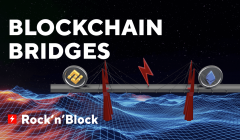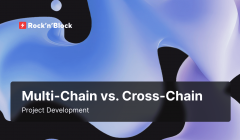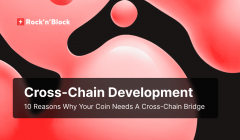Demystifying Cross-Chain Bridge Development
03 May 2024The emergence of cross-chain bridge development addresses the native isolation that limits the potential of separate blockchains. This article explores the imperative behind cross-chain bridge development, delving into the existing types and providing insights on how to select the most appropriate bridge for your project.
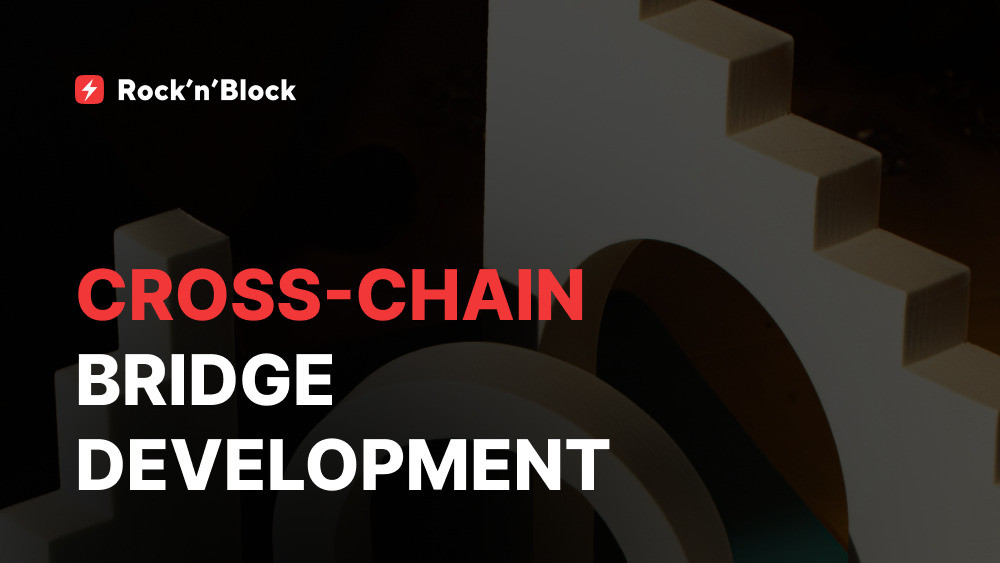
Table of Contents:
-
What Is a Cross-Chain Bridge
-
Why Cross-Chain Bridge Development Is Needed
-
Cross-Chain Bridge Development Types
-
Cross-Chain Bridge Development Types By Architecture
-
Cross-Chain Bridge Development Types By The Principle Of Token Issuance
-
Conclusion
What Is a Cross-Chain Bridge
Cross-chain bridge development is a pioneering aspect of blockchain technology that aims to create interoperability solutions connecting disparate blockchain networks. Essentially, a cross-chain bridge serves as a technological link, enabling seamless transfer of assets, data, or functionalities between different blockchains.
These bridges typically leverage smart contracts, oracles, and consensus mechanisms to facilitate secure and trustless transactions between blockchains.
As the attention grew, many cross-chain bridges emerged, each offering unique features and functionalities. To navigate this expanding landscape, project owners must understand the basic principles of cross-chain bridges and determine which one best fits their project's specific needs and goals.
Why Cross-Chain Bridge Development Is Needed
Project owners face several challenges that cross-chain bridge development aims to address. These challenges often revolve around improving interoperability, increasing liquidity, and fostering a more seamless and efficient decentralized ecosystem. Here are some problems project owners face and how cross-chain bridge development can assist:
1. Isolated Ecosystems
Different blockchains operate in isolation, limiting the seamless transfer of assets and information between them. Cross-chain bridge development facilitates interoperability, allowing assets to move between diverse blockchain networks, breaking down silos and fostering a more interconnected ecosystem.
2. Limited Market Access
Projects on a specific blockchain have a limited user base, and accessing users on other blockchains can be challenging. Cross-chain bridge development enables projects to tap into a broader market by extending their reach to users on different blockchains, increasing exposure and potential user adoption.
3. Asset Liquidity Challenges
Limited liquidity can impede the efficiency of decentralized financial applications, affecting the smooth operation of lending, borrowing, and trading platforms. Cross-chain bridge development enhances liquidity by allowing assets to be transferred seamlessly between blockchains, promoting more vibrant and liquid markets on both sides of the bridge.
4. Fragmented Token Ecosystems
Token standards and formats vary across blockchains, creating a fragmented ecosystem. Cross-chain bridges provide a mechanism for translating and transferring tokens between different standards, promoting a more standardized and cohesive token economy.
5. Community Engagement and Adoption
Building and sustaining community engagement can be challenging, especially when user bases are fragmented across different blockchains. Cross-chain bridges create opportunities for collaborative communities, bringing together users from various blockchains, fostering a more engaged and interconnected user base.
By addressing these challenges, cross-chain bridge development provides project owners with the tools to create a more versatile, interconnected, and user-friendly blockchain ecosystem, promoting innovation and collaboration across multiple networks.
Cross-Chain Bridge Development Types
Selecting the appropriate cross-chain bridge solution is similar to choosing a crucial infrastructure component. It requires careful consideration of the bridge's design, underlying technology stack, and track record. In this fast-paced environment, it is crucial to stay up-to-date with the latest developments, engage in community discussions, and seek expert advice to make informed decisions about which cross-chain bridge is best suited for your blockchain project.
Let's explore cross-chain bridge development types and the factors that can guide you in selecting the most suitable one for your project.
Cross-Chain Bridge Development Types By Architecture
In this section, we will explore key types of cross-chain bridges classified by their architecture and discuss their suitability for different projects and scenarios.
Multisig Bridges
Multisig bridges utilize a multi-signature (multisig) approach, requiring multiple cryptographic signatures from validators for transactions to be executed. This enhances security and reduces the risk of single points of failure.
Technical Mechanism:
-
Validators: Deployed on independent servers, manage event catching, data collection. The signatures of three interdependent validators ensure the tx data passed to the relayers is valid and correct.
-
Relayers: Deployed on independent servers, manage signature collection and validation, transfer function call on smart contracts in target network. These addresses initiate and sign the transactions from the swap contract in the target network to the user wallet.
-
Smart Contracts: Bridge smart contracts automate cross-chain asset transfers, ensuring security by collecting validator signatures and preventing double-spending through transaction information checks.
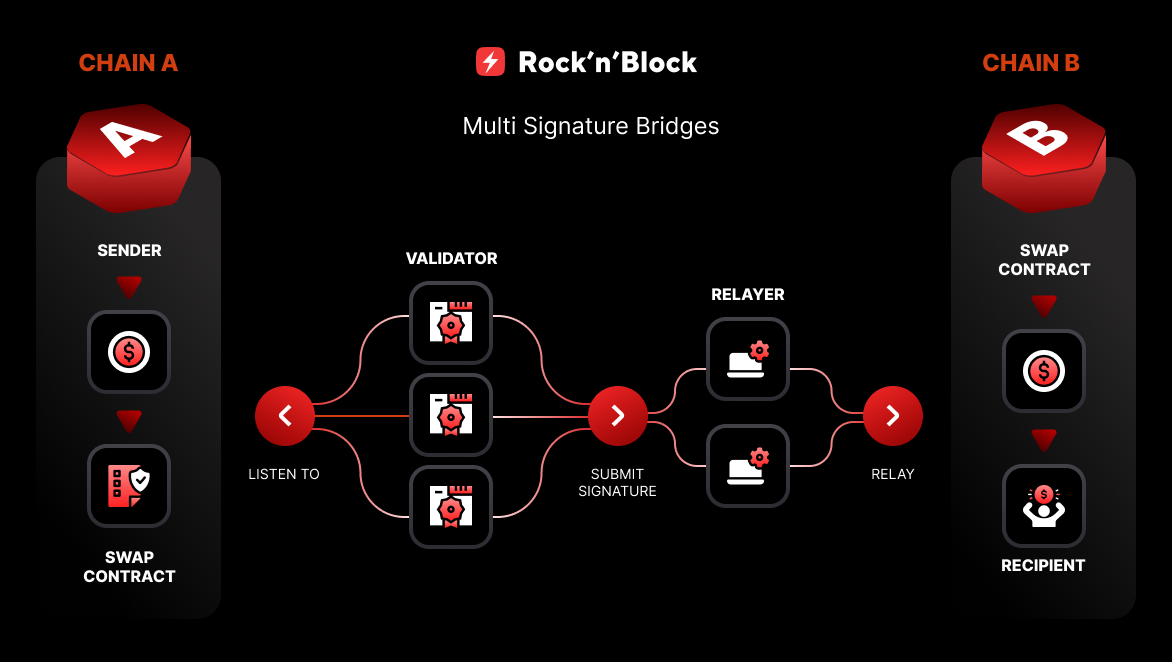
When the event of a transaction occurs, tokens are sent from the user’s wallet to the swap contract in the original network. Scanners on the validators scan swap contracts in the original network for the deposit events and collect the data about the tx, its hash, transferred amount, target network, etc. Validator signs the data with its private key and passes it to the relayer. When a relayer receives ⅔ signatures from validators, it initiates transfer from the contract in the target network. The tokens remain locked in the swap contract in the original network and the same amount of tokens is unlocked in the target network and sent to the user's wallet.
Proof of Authority Bridges
Cross-chain bridge development using Proof of Authority (PoA) ensures secure, non-custodial asset transfers between blockchains. PoA relies on trusted nodes to confirm data authenticity, with appointed node owners verifying incoming data.
Technical Mechanism:
-
Authority Nodes: PoA bridges rely on a predefined set of authority nodes that possess the privilege to validate transactions. These nodes are typically selected based on their reputation, identity verification, or specific criteria set by the blockchain network.
-
Transaction Validation: Validators, or authority nodes, validate transactions based on the PoA consensus. Once transaction data is validated, transactions are placed to the target network by calling transfer function in the bridge smart contract.
-
Permissioned Network: PoA bridges often operate in a permissioned or semi-permissioned network, where the authorities are known entities with predetermined roles and responsibilities.
Bridge Operation Flow:
1. Source Chain (Chain A)
Users initiate the transfer by specifying the number of tokens and the sender's address. These tokens are locked within the smart contract (lock-contract) on Chain A, and relevant data is transferred to a Node.
2. Node in the Cross-Chain Bridge
The Node serves as a vital component, acting as a data transmission tool. It collects external data, such as transaction events, authenticates it, signs it for validation, and then sends it to the blockchain for use by smart contracts
3. Destination Chain (Chain B)
On Chain B, the smart contract (mint contract) receives transaction information from the blockchain. Using this information, it releases a copy of the locked asset from Chain A, creating wrapped tokens. These wrapped tokens are subsequently forwarded to the intended recipient.

Using Consensus Votes Between Oracles
The PoA consensus algorithm ensures transaction correctness by relying on the reputation of oracles. Trusted node owners are appointed to verify the authenticity of incoming data. If more than 51% of these trusted voters confirm the data's validity, it is considered legitimate. This consensus mechanism adds an extra layer of security to the bridge's operation.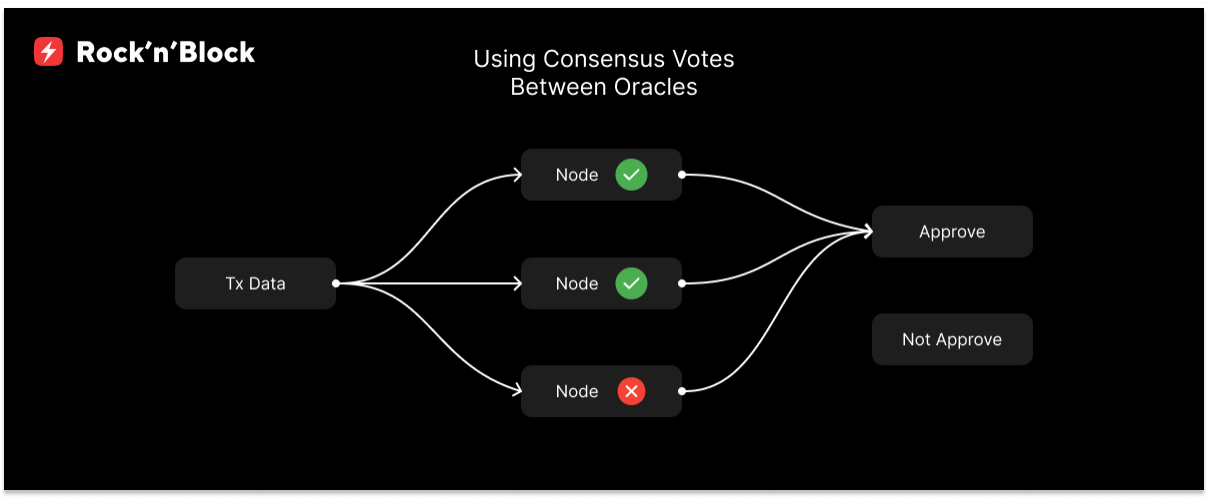
Atomic Swaps
Atomic swaps, a concept in cross-chain bridge development, enable trustless, peer-to-peer exchanges of different cryptocurrencies. This process ensures that either both parties involved in the exchange receive the agreed-upon assets, or the transaction doesn't occur at all.
Technical Mechanism:
-
Hash Time Locked Contracts (HTLCs): Atomic swaps utilize HTLCs, a type of smart contract that enables conditional transactions. This mechanism ensures that funds are only released when predetermined conditions, like a secret cryptographic hash, are met.
-
Pre-image Hashing: To initiate an atomic swap, both parties generate a code, and a hash of that code is created. The hash is then shared with the other party. Each party then creates a transaction to release funds using the hash as a condition.
-
Simultaneous Execution: Both transactions are relayed to their respective blockchains. The recipient can claim their funds by revealing the pre-image (the code) that corresponds to the hash. If one party fails to claim their funds or doesn't reveal the code, the other party can reclaim their funds.
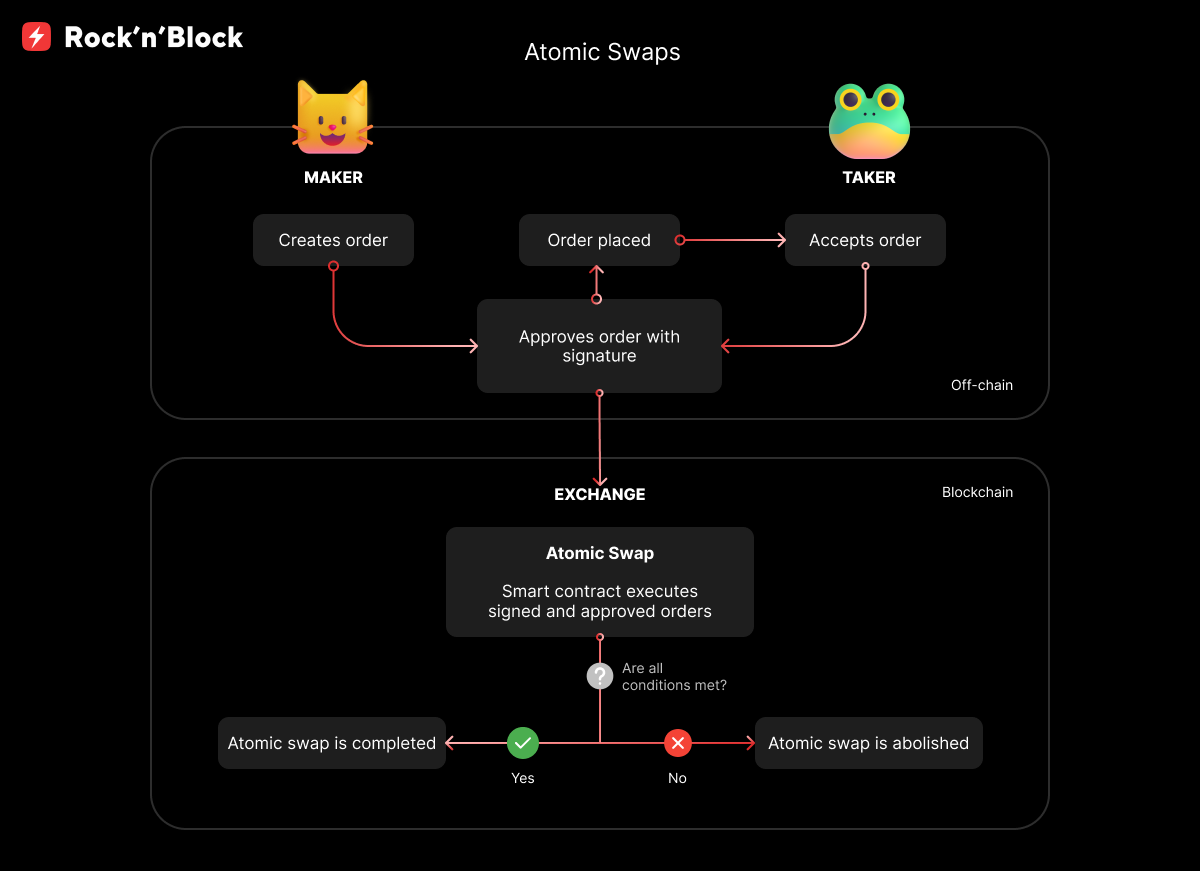
Bridge Aggregators
This type of cross-chain bridge development acts as a platform that connects to multiple existing bridges, forming a network to facilitate cross-chain transactions. Bridge aggregators provide users with a comprehensive token exchange route through various bridges.
Technical Mechanism:
-
Integration with Multiple Bridges: Bridge aggregators integrate with various existing cross-chain bridges, forming a network that spans multiple blockchain protocols.
-
Token Exchange Routing: Users initiate transactions on the bridge aggregator platform, which then determines the most optimal route for the exchange, utilizing the interconnected bridges to facilitate cross-chain asset transfers.
-
Liquidity Aggregation: Bridge aggregators may also aggregate liquidity from different sources, enhancing the overall liquidity pool available for users on the platform.
Cross-Chain Bridge Development Types By The Principle Of Token Issuance
This section will examine various types of cross-chain bridges categorized by the method of token issuance and evaluate their appropriateness for different DeFi projects.
Lock and Mint/Burn Cross-Chain Bridge Development
Lock and mint cross-chain bridges are designed to enable the secure transfer of assets from one blockchain to another by locking assets on the source blockchain and minting corresponding assets on the destination blockchain. This approach provides a mechanism for users to seamlessly move assets between different blockchain networks.
Technical Mechanism:
-
Locking Mechanism: Users initiate a transaction to lock assets on the source blockchain. This typically involves sending the assets to a smart contract or a specific address, ensuring they are temporarily held in custody.
-
Minting Process: Once the assets are locked and tx data is passed to the target network swap smart contract. The corresponding amount of assets is minted on the destination blockchain, creating a representation of the locked assets - Wrapped Tokens.
Burn and Mint Cross-Chain Bridge Development
Burn and mint cross-chain bridges facilitate the transfer of assets between different blockchain networks by burning assets on the source blockchain and minting corresponding assets on the destination blockchain.
Technical Mechanism:
-
Burning Process: Users initiate a transaction to burn a specific quantity of assets on the source blockchain. This action is usually facilitated through smart contracts or specific protocols, ensuring the irreversible destruction of the locked assets.
-
Minting Mechanism: Once the burning process is confirmed on the source blockchain, the bridge on the destination blockchain is notified. Then, an equivalent amount of assets is minted on the destination blockchain, representing the burned assets.
-
Synchronization: Burn and mint bridges maintain a synchronization mechanism to ensure that the burning and minting processes occur in tandem, preventing mismatches between the two blockchains.
Lock and Unlock Cross-Chain Bridge Development
Lock and unlock cross-chain bridge development enables the secure transfer of assets between different blockchain networks by locking assets on the source blockchain and unlocking them on the destination blockchain. This approach ensures a bidirectional movement of assets while maintaining a synchronized and secure process.
Technical Mechanism:
-
Locking Process: Users initiate a transaction to lock assets on the source blockchain. This involves transferring assets to a smart contract or a specified address, securing them until the unlocking conditions are met.
-
Unlocking Mechanism: Once the locking process is complete and verified, the bridge on the destination blockchain is notified. The corresponding amount of assets is then unlocked on the destination blockchain, allowing users to access and utilize them.
The suitability of these cross-chain bridge types depends on the specific requirements of the platform or application. Lock and mint, burn and mint, and lock and unlock bridges offer distinct advantages, and the choice should align with the platform's use case, desired speed, and the importance of total supply consistency.
Conclusion
As the blockchain ecosystem grows, the ability to seamlessly connect and collaborate across different blockchains will help shape the future of decentralized technology. To achieve effective cross-chain integration, it is important not only to overcome technical challenges, but also to embrace the collaborative spirit that these bridges foster. By understanding the basics of cross-chain bridge development, embracing the variety of bridge types, and making informed decisions, you can effectively navigate the cross-chain landscape, opening up new opportunities for innovation and collaboration in the decentralized space.
We ❤️ Development
Follow us on social media to receive the hottest blockchain development updates
